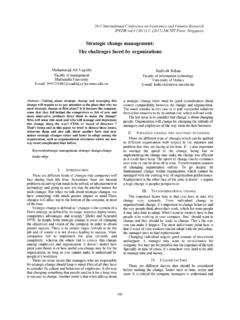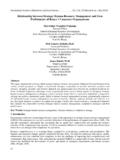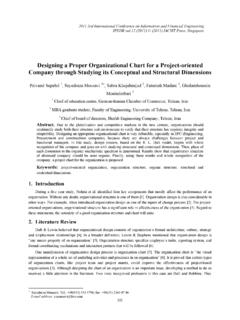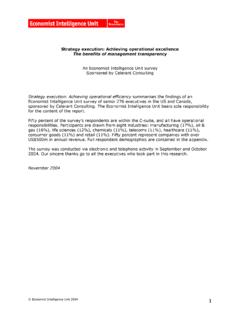Transcription of Understanding the Concept of Strategic Intent - IRJES
1 International Refereed Journal of Engineering and Science ( IRJES ) ISSN (Online) 2319-183X, (Print) 2319-1821 Volume 4, Issue 6 (June 2015), 57 | Page Understanding the Concept of Strategic Intent *Mburu, and Thuo, 1 Student, PhD, School of Business, Kenyatta University, Kenya 2 Supervisor, School of Business, Gretsa University, Kenya Abstract:-This conceptual paper is a review of the Concept of Strategic Intent in relation to the Strategic management theories. It reviews literature on Strategic management theories stemming from the origin of the word Strategic management to the current discussion on Strategic Intent . The Concept of Strategic Intent inspires the management leadership as the way to bring future into current thinking thus allowing them to reorganize the organization for future competition by developing products, core competencies, systems and relationship that will give them a competitive edge.
2 The paper has identified that Strategic Intent goes beyond the Strategic planning to get a deeper imagination of where the organization should be 10 20 years into the future. This article is suggested to be an additional work into the Understanding of Strategic Intent Concept as one of the emerging issues in management Keywords:- Strategic Intent , Strategic management, strategy I. INTRODUCTION The topic of this article is the Concept of Strategic Intent . Strategic Intent was first discussed by Hamel and Prahalad in 1984 but it gained momentum when it was first published by the Harvard Business School in 1989 (Hamel and Prahalad, 1989). This article briefly examines the evolution of the Strategic Intent tracing the Concept from Strategic Management.
3 It analyses literature linking Strategic Intent to Strategic management and concludes by suggesting the adoption of the article into the discourse of Strategic Intent . The background of Strategic Management Strategic Management can be traced back into the Greek history where the word strategy is derived. Strategy comes from a Greek word Strategosmeaning a general with its root meaning army and lead (Bracker, 2001). The management science practice is believed to have been in existence for as long as the human being and can be traced back to 5000 BC but came to maturation with Freiderick Winslow Taylor in 1911, HenriFayol in 1916, and Max Weber in 1947 (Celic and Dogan 2011). The Taylor, Fayol and Weber work is commonly referred to classical theories which is a viewpoint that emphasizes finding ways of managing work and organization more efficiently (Bartol and Martin, 1991) Taylor was the first to discuss the subject of management science by developing four basic principles:1) Scientifically studying each part of the work and develop best method of performing the task and not working haphazardly.
4 2) Carefully selecting worker, training him / her to perform the task in a scientifically developed method not in an inconsistent manner and incoherent way. 3) Corporate fully with workers to ensure that they use the proper method and 4) Divide work and responsibility so that management are responsible for planning and the worker is responsible for executing(Barton and Martin, 1991, Celic and Dogan 2011). In 1916 HenryFayoltook the work of Taylor further by transposing the small enterprise Concept into a large enterprise. He discussed the Concept of analyzing the whole organization to develop good organizational design and management principles such as division of labor and specialization, authority and responsibility and discipline (Celic and Dorgan 2011)the major shift between Taylor and Fayol s work is that Fayol was more keen on the human factor than Taylor.
5 Max Weber was thought to have a bureaucratic approach to his management thinking away from Taylor and Fayol s approach. The approach emphasizes on the need for organizations to operate in a rational manner rather than relying on the management or the owner (Bartol and Martin, 1991, Celic and Dorgan, 2011). However, the three are categorized as classical approaches because they were formed in the same environmental condition. Thereafter other authors have developed concepts and definitions of Strategic management from the time of Neuman and Morgenstaernin 1947 (The game theory) to Schendel and Hofer in 1979 (Bracker, 1990) Understanding the Concept of Strategic Intent 58 | Page Definitions of Strategic Intent and where it resides Following the introduction of the subject of Strategic Intent by Hamel and Prahalad (1987), authors have come up with various definitions trying tocreate an Understanding the key drivers as outlined below.
6 Author Definition for Intent Subject in possession of the Intent Parahalad&Doz, (1987) Goal for which one cannot plan, long-term orientation: Intent is used here to describe long term goals and aims rather than detached plans Top management with no mention of employees Firms action and Intent discussed only in singular form Hamel and Prahalad (1989) Shared obsession to win All organization members Hamel and Prahalad (1994) A dream, an emotion, distillation of strategy, a goal, a mission All organization members Burgelman (1994) A prophesy, a foresight by Burgelman and Grove, (1996) Top management decision Hart (1992) Mission (Superior goal) for the organization Multiple organization members Noda and Bower (1996) Top management viewpoint on business, (Corporate context) Top management (showing Intent in bottom up ideas)
7 Lovas and Ghoshal (2000) A statement of goals articulated by the top management Top management Strategic Management and Strategic Intent Link As management science developed, the Concept of Strategic management came into play. From the 1960 s the subject of Strategic management became a subject of study and discussion in management practice and business schools, building on the Taylor, Fayol and Weber s work. Formal management arises from human trying to meet their needs that has found it necessary to find a fit in coexistence(Celic and Dogan2011). The new paradigm of Strategic management has given rise to discussions to subjects such as Strategic Intent , Strategic fit and knowledge management among other subjects. Strategic management links with Strategic Intent on the fact that Strategic management helps organization develop the ability to deal with uncertain future by defining a procedure for accomplishing goals (Bracker1990).
8 The earliest discussion on Strategic intentdescribe Strategic Intent as the long term goal and aims of an organizationPrahalad and Doz (1987). Strategic leaders take a long term (10-20 years) view of their purpose and goals set out the way getting there which they referred to as Strategic Intent (Hamel and Prahalad 1989). Intent may be more appropriate for leaders of organizations in dynamic global environment. Strategic Intent is a useful Concept for purpose of continuity in an organization adopting internal and external pressure. It represents a proactive mode of strategizing, a symbol of being futuristic(Mantere and Sillince, 2007). Strategic Intent is distinguished from other similar concepts such as Strategic fit(Hamel and Prahalad (1994).)
9 In Strategic Intent , they introduce aspects of flexibility than traditional Strategic management models. Strategic Intent captures the essence of winning, is stable over time, and sets goals that require personal commitment. Strategic Intent envisions a desired leadership position and establishes the criterion organizations will use to chart its progress (Smith 1994). Strategic Intent is an ambitious and compelling attempt that provides emotional and intellectual energy for the future. Strategic Intent should not be confused with two other words used in Strategic management namely vison and goal. Whereas goal is futuristic it differs from Strategic Intent in that Strategic Intent is independent of the Strategic plan and is not precise in its nature (Romar, 2009) Evolution of Strategic Intent Concept Hamel and Prahalad Concept on Strategic Intent is among the latest thinking in this century stemming from Strategic management.
10 It has evolved from the management science to Strategic management and now the focus in looking at the future. Hamel and Prahalad (1989) confidently discusses the subject by giving a model of the process of developing Strategic Intent and linking it with other recently developed theories such as foresight, Strategic architecture and core competence to craft the future. In their book competing for the future Hamel and Prahalad discuss the importance of Strategic Intent in organization s endeavor to build their future. Strategic Intent differs from Strategic planning in that Strategic plan focuses on the means to the end while Strategic Intent defines the end leaving room for Strategic planning Understanding the Concept of Strategic Intent 59 | Page process to focus on the means (Hamel and Prahalad 1989).









